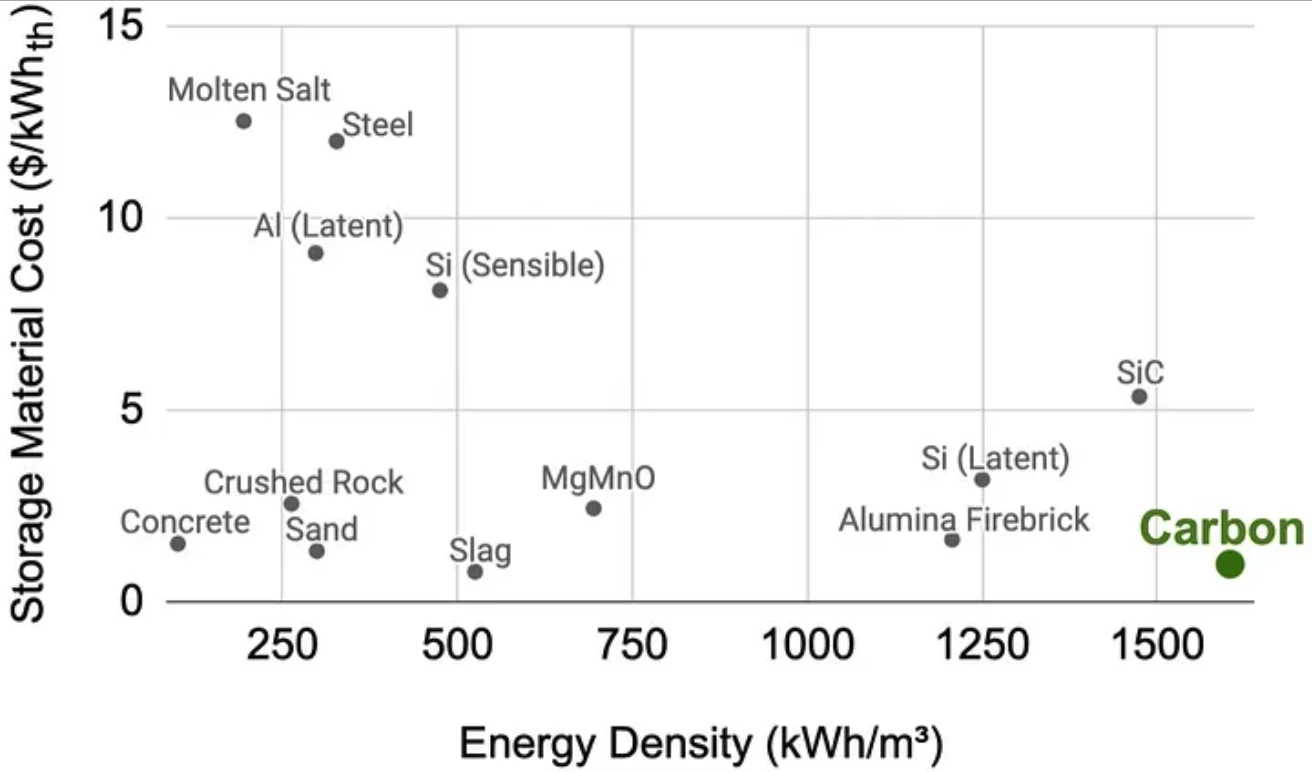Bill Gates-backed startup Antora Energy is preparing to roll out a containerized, modular heat battery, designed to store renewable energy at the lowest possible cost – then release it efficiently as electricity or industrial process heat.
It's all in the name of decarbonizing heavy industry – a job that simply needs to be done, and a tricky one given the intermittent nature of renewable energy. It's easy for factories to run 24/7 when there's fossil fuel available to create heat as required, but what about when the Sun's not shining?
We've written before about Rondo's "brick toaster" heat batteries, which propose a solution: use cheap renewable energy to heat up regular old clay bricks in insulated containers, then recover that energy as needed at about one-fifth the cost of a chemical battery, in the form of process heat at up to 1,500 °C (2,700 °F). Using cheap, abundant materials, Rondo hopes to deploy this solution at colossal scale, with no less of a goal than reducing global CO2 emissions by 15% within 15 years.

Antora believes its carbon-based system could be even cheaper and more useful, because it can store energy at upwards of 2,000 °C (3,632 °F), changing the way the energy can be extracted, both as heat, and also as electricity through super-efficient thermophotovoltaic panels.
Co-founder and CEO Andrew Ponec explained Antora's choice of carbon blocks in a Medium post, but in essence:
- As a waste product of several other industrial processes and a common input to the metals industry, these blocks are available in virtually unlimited quantities, through well established supply chains
- "Among the least expensive bulk thermal storage materials available," with a materials cost around US$1/kWh – about 50 times cheaper than lithium-ion batteries
- They're non-toxic, conflict-free, and cause no environmental issues in solid form
- High thermal conductivity, and high mechanical strength that increases as it gets hotter, gives solid carbon the ability to rapidly absorb large amounts of energy
- The blocks remain solid at upwards of 3,000 °C (5,432 °F), roughly twice the temperature at which steel melts, sidestepping many issues found with molten salts, and other liquid heat storage media
- High energy density makes these carbon blocks easy to transport, and gives Antora's heat batteries a small footprint on site
- They're compatible with ultra-high temperature applications

"The final advantage of the extreme temperature stability of carbon is related to heat transfer," wrote Ponec. "Radiative heat transfer is proportional to the temperature of the source object raised to the fourth power (T⁴), so if you double the temperature you increase the radiative heat transfer by 16 times. That’s a powerful scaling factor! The upshot is that at temperatures above 1,500 °C, heat transfer works completely differently than we’re used to at room temperature. Radiation dominates over conduction and convection. For example, at 2,000 °C, over 99% of heat transfer occurs through light, not conduction and convection."
Antora's system thus harnesses the thermal glow off its carbon bricks using light radiation, which Ponec describes as "much simpler, cheaper and more reliable than the alternatives." If a customer wants the energy back as heat, the system will heat up tubes containing steam, hot air or some other process fluid, which can be piped around the facility wherever heat is required.
If the customer wants electricity, Antora can convert the heat to provide it. "We shine it on modified photovoltaic panels (similar to solar panels) to generate electricity," explained Ponec. "Our team has developed a world-record-breaking solid-state heat engine that converts radiant heat into electricity with only a few micrometers of material and no moving parts. This is a story for another day, but for now let’s just say it’s quite useful to have a compact, power-dense, scalable, and efficient device capable of converting heat into electricity!"

This makes us think of a breakthrough thermophotovoltaic (TPV) cell out of MIT that we wrote about last year, capable of converting heat into electricity at efficiency levels around 40% – significantly better than the humble steam turbine, which averages closer to 35%. Indeed, the researchers involved mentioned a graphite-based heat storage and recovery system as one of their chief goals.
Since Antora is also an MIT spinout, we wondered if it might indeed be this TPV heat engine that's used in Antora's carbon heat battery system. But no, it appears to be using a different gallium indium arsenide TPV cell developed by a separate team, with an efficiency that's been demonstrated at 38.8% in a paper published last November in the journal Joule.
Antora told MIT News that it's already opened a manufacturing facility for these TPV cells – the biggest such factory in the world, with a projected capacity of 2 MW of cells per year. It's working on industrial projects in the 30-60 MW range, across the United States, expecting to see carbon battery installations come online from around 2025, and the company hopes to scale aggressively.
The carbon heat batteries are containerized, so they can be assembled at a central factory and easily shipped out to site, where clients can install as many as they need in a modular formation.
Source: Antora Energy







